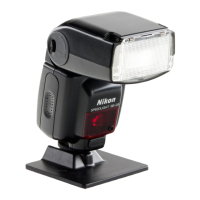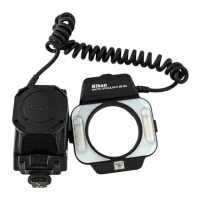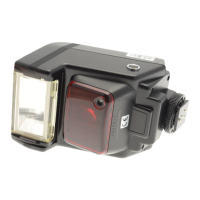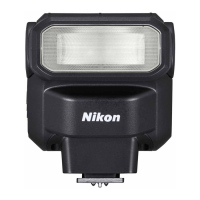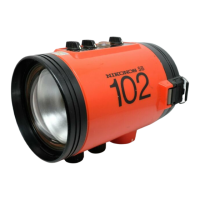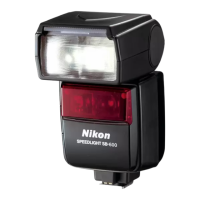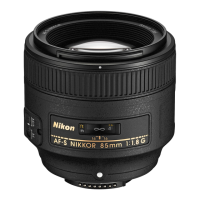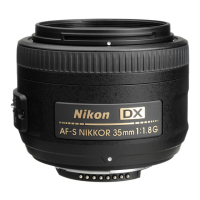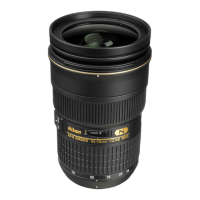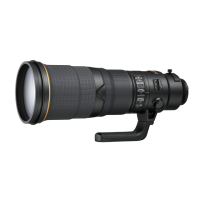Do you have a question about the Nikon SB-26 and is the answer not in the manual?
Explains how to use the manual by following camera-specific index tabs for optimal understanding.
Identifies key parts of the SB-26 flash unit and their functions for user reference.
Overview of the SB-26's versatile features and functions for flash photography.
Explains how fill flash reduces shadows and balances ambient light for natural effects.
Enables flash synchronization at faster shutter speeds for blurred backgrounds.
Creates light trails by firing flash at the end of exposure for moving subjects.
Illuminates subject's eyes before flash to reduce red-eye effect.
Enables strobo-effect multiple flash exposures for special effects.
A comparison chart showing flash operations available for various Nikon cameras.
Step-by-step guide for initial preparations like installing batteries and attaching the flash.
Instructions on how to properly load batteries into the flash unit.
Guide on how to securely mount the flash unit onto the camera's accessory shoe.
How to check if batteries are properly installed and provide sufficient power.
Explains how to use the LCD panel for various functions and adjustments.
How to set the flash head to the standard horizontal/front position for optimal flash.
How to use the LCD panel to compute appropriate shooting distances.
Guide for manually setting the ISO film speed for accurate flash exposure.
Instructions for manually setting the aperture value for flash exposure.
How to manually adjust the zoom-head position for desired light coverage.
Using TTL Auto Flash mode for fill-flash with automatic exposure control.
Detailed guide for TTL Auto Flash mode with specific Nikon camera models.
Explains how to select the appropriate flash method based on camera and lens settings.
Information on using 1/300 sec. TTL High-Speed Sync with the F5 camera.
Steps for setting up the SB-26 for TTL Auto Flash mode with compatible cameras.
Verifying all settings are correct before shooting in TTL Auto Flash mode.
Step-by-step guide on how to fire the flash in TTL Auto Flash mode.
Using Non-TTL Auto Flash with different lens apertures.
Practical steps for Non-TTL Auto Flash setup and usage.
How to manually control flash output levels from full power to 1/64.
Fine-tuning light output in increments of +/- 1/3 stop.
Automatic aperture adjustment for certain camera/lens combinations in manual mode.
Using repeating flash for multiple exposures on a single frame.
Calculating appropriate shutter speed based on flash frequency and number of flashes.
Using FP High-Speed Sync for faster shutter speeds and blurred backgrounds.
How to use red-eye reduction for better flash portraits.
Creates light trails by synchronizing flash to the rear curtain for moving subjects.
Manually adjusting flash output to make the subject lighter or darker.
Adjusting background exposure using the camera's compensation dial.
Using the open flash button for test firing and checking light.
Using the wide flash adapter for wider lens coverage.
How to lock the zoom-head position for specific lens types or conditions.
Using the AF assist LED for autofocus in low light conditions.
How to use the STBY position to conserve energy and reduce recycling time.
Using guide numbers to calculate the correct aperture for flash photography.
Techniques for diffusing light to soften shadows and create pleasing portraits.
How to use diffusers to soften flash light and improve image quality.
Specific guidance for TTL Auto Flash when photographing very close subjects.
Techniques for using multiple flash units for advanced lighting effects.
Setting up the SB-26 for wireless slave flash photography.
Connecting multiple flash units using sync cords for TTL or manual photography.
Performing multiple flash photography using manual flash mode for each unit.
A chart showing compatible master/slave units and sync cords for TTL multiple flash.
Explains the difference between NORMAL (front-curtain) and REAR sync modes.
Guidelines for maintaining and caring for the SB-26 speedlight.
Information on battery types, care, and usage for the speedlight.
Technical specifications of the SB-26 speedlight, including dimensions and power.
Tables showing shooting distance ranges based on aperture, film speed, and zoom settings.
Explains how to use the manual by following camera-specific index tabs for optimal understanding.
Identifies key parts of the SB-26 flash unit and their functions for user reference.
Overview of the SB-26's versatile features and functions for flash photography.
Explains how fill flash reduces shadows and balances ambient light for natural effects.
Enables flash synchronization at faster shutter speeds for blurred backgrounds.
Creates light trails by firing flash at the end of exposure for moving subjects.
Illuminates subject's eyes before flash to reduce red-eye effect.
Enables strobo-effect multiple flash exposures for special effects.
A comparison chart showing flash operations available for various Nikon cameras.
Step-by-step guide for initial preparations like installing batteries and attaching the flash.
Instructions on how to properly load batteries into the flash unit.
Guide on how to securely mount the flash unit onto the camera's accessory shoe.
How to check if batteries are properly installed and provide sufficient power.
Explains how to use the LCD panel for various functions and adjustments.
How to set the flash head to the standard horizontal/front position for optimal flash.
How to use the LCD panel to compute appropriate shooting distances.
Guide for manually setting the ISO film speed for accurate flash exposure.
Instructions for manually setting the aperture value for flash exposure.
How to manually adjust the zoom-head position for desired light coverage.
Using TTL Auto Flash mode for fill-flash with automatic exposure control.
Detailed guide for TTL Auto Flash mode with specific Nikon camera models.
Explains how to select the appropriate flash method based on camera and lens settings.
Information on using 1/300 sec. TTL High-Speed Sync with the F5 camera.
Steps for setting up the SB-26 for TTL Auto Flash mode with compatible cameras.
Verifying all settings are correct before shooting in TTL Auto Flash mode.
Step-by-step guide on how to fire the flash in TTL Auto Flash mode.
Using Non-TTL Auto Flash with different lens apertures.
Practical steps for Non-TTL Auto Flash setup and usage.
How to manually control flash output levels from full power to 1/64.
Fine-tuning light output in increments of +/- 1/3 stop.
Automatic aperture adjustment for certain camera/lens combinations in manual mode.
Using repeating flash for multiple exposures on a single frame.
Calculating appropriate shutter speed based on flash frequency and number of flashes.
Using FP High-Speed Sync for faster shutter speeds and blurred backgrounds.
How to use red-eye reduction for better flash portraits.
Creates light trails by synchronizing flash to the rear curtain for moving subjects.
Manually adjusting flash output to make the subject lighter or darker.
Adjusting background exposure using the camera's compensation dial.
Using the open flash button for test firing and checking light.
Using the wide flash adapter for wider lens coverage.
How to lock the zoom-head position for specific lens types or conditions.
Using the AF assist LED for autofocus in low light conditions.
How to use the STBY position to conserve energy and reduce recycling time.
Using guide numbers to calculate the correct aperture for flash photography.
Techniques for diffusing light to soften shadows and create pleasing portraits.
How to use diffusers to soften flash light and improve image quality.
Specific guidance for TTL Auto Flash when photographing very close subjects.
Techniques for using multiple flash units for advanced lighting effects.
Setting up the SB-26 for wireless slave flash photography.
Connecting multiple flash units using sync cords for TTL or manual photography.
Performing multiple flash photography using manual flash mode for each unit.
A chart showing compatible master/slave units and sync cords for TTL multiple flash.
Explains the difference between NORMAL (front-curtain) and REAR sync modes.
Guidelines for maintaining and caring for the SB-26 speedlight.
Information on battery types, care, and usage for the speedlight.
Technical specifications of the SB-26 speedlight, including dimensions and power.
Tables showing shooting distance ranges based on aperture, film speed, and zoom settings.
| Power Source | 4 x AA batteries |
|---|---|
| AF Assist | Yes |
| Rear Curtain Sync | Yes |
| Type | External Flash |
| Zoom Range | 24mm |
| Flash Modes | TTL, Manual |
| Guide Number | 36 (ISO 100, in meters) |
